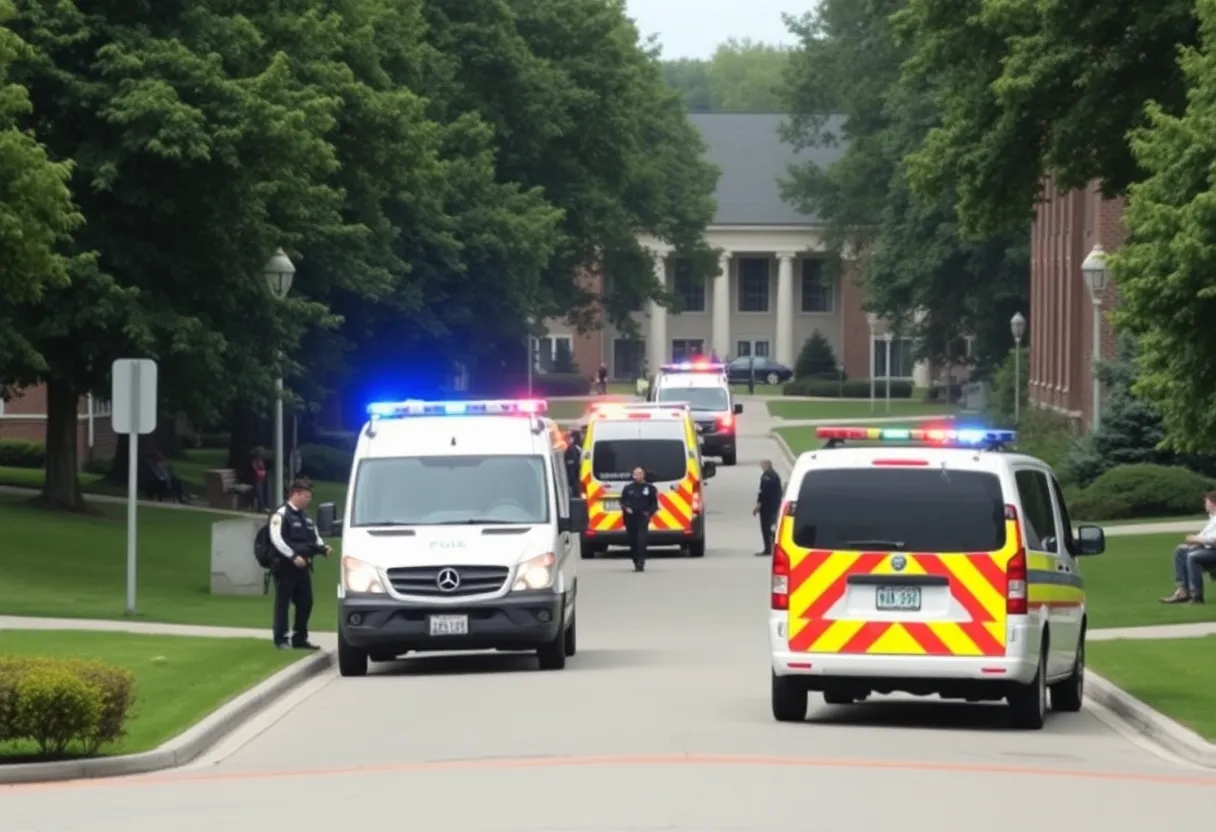Boston, October 15, 2025
News Summary
A false shooting report at the University of Massachusetts Boston prompted a swift response from multiple law enforcement agencies, including a full SWAT callout. The situation, triggered by various emergency calls reporting shots fired on campus, led to significant confusion as no actual danger was found. The communications and alert protocols during the incident are now under scrutiny, particularly regarding the lack of a ‘shelter in place’ alert despite serious safety concerns raised at the time.
Boston
False shooting report at UMass Boston triggers broad law enforcement response and confusion
A false shooting report at UMass Boston led to significant confusion among law enforcement, according to Boston Police Department (BPD) documents. Multiple agencies mobilized across the campus after a series of emergency calls, triggering a FULL SWAT CALL OUT and precautionary lockdown guidance for students, but no evidence of an actual shooting was found.
Key facts from official logs and campus communications
- There were 12 calls to 911 between 3:42 p.m. and 5:09 p.m. on September 11 regarding the incident.
- The first safety alert sent by campus police about the residence halls was at 4:01 p.m.
- The initial caller reported hearing shots fired at the residence hall, although the number of shots was redacted from the reports.
- Multiple law enforcement agencies responded, including all available Boston Police assets, UMass Boston Police, Massachusetts State Police, Boston Fire, and Boston EMS.
- Upon arrival, officers could not locate the original caller who made the shooting report, and that caller did not respond to callbacks from dispatchers.
- Dispatch logs indicated that law enforcement believed there was an active shooter on the 10th floor by 3:51 p.m.
- A “FULL SWAT CALL OUT” was initiated at 3:56 p.m.
- As SWAT teams cleared the east residence hall, another report came in regarding “POSSIBLE SHOTS FIRED” at the Campus Center, later clarified as “SHOTS FIRED DUNKIN DONUTS.”
- Officers entering the Dunkin Donuts found that no one was reporting shots fired.
- A call from a student in a classroom about shots fired at the campus center turned out to be based on repeated claims from other students via text messages.
- Another report described a suspicious object located between the Healy building and Campus Center, though details were redacted.
- The suspicious object was noted as not having visible wires or smoke.
- SWAT and K9 units were deployed to assist, along with a technician in a bomb suit.
- At 3:57 p.m., UMass Boston Police were advised to notify students to go into lockdown.
- The first alert sent at 3:47 p.m. was labeled “avoid the area”, followed by another alert categorized as a “public safety threat,” advising residents to stay in their rooms.
- No official “shelter in place” designation was ever sent out by the university, despite the seriousness of the incident.
- UMass Boston’s emergency alert system classifies messages into “Avoid Area,” “Public Safety Threat,” “Shelter in Place,” or “Evacuation.”
- The Director of Communications, DeWayne Lehman, declined to explain why a “shelter in place” alert was not utilized.
- Templates for alerts regarding “Gun shots reported” and “Unconfirmed Bomb Threat” were available; however, neither was used during the incident.
- The incident adds to concerns about protocol adherence during emergency situations at UMass Boston.
What happened first and why it escalated
The sequence began with multiple 911 calls reporting shots and a possible shooter. Dispatch records show law enforcement believed there was an active shooter on the 10th floor by 3:51 p.m., prompting a rapid escalation to a FULL SWAT CALL OUT at 3:56 p.m. SWAT, K9 units, state police, campus police, Boston Fire, and Boston EMS converged on campus to clear residence halls and public spaces.
As officers swept the east residence hall, separate reports surfaced about possible shots in the Campus Center and at a campus Dunkin Donuts. Those reports were investigated and found to have no on-site confirmations of shots fired. A classroom report also traced back to repeated text-message claims among students rather than independently verifiable observations.
Alerts, classifications, and communication decisions
Campus alert activity began with a message at 3:47 p.m. labeled “avoid the area.” A later message, categorized as a “public safety threat,” advised residents to stay in their rooms. The first safety alert specifically aimed at residence halls was sent at 4:01 p.m. Despite the escalation and a recommendation at 3:57 p.m. that UMass Boston Police notify students to go into lockdown, the university did not send an official “shelter in place” alert. The Director of Communications declined to explain why that specific alert was not used. Templates for messages labeled “Gun shots reported” and “Unconfirmed Bomb Threat” were available in the system but were not deployed during the incident.
Operational and procedural issues raised
Logs and after-action materials highlight several operational challenges: locating and verifying the original caller, rapid spread of unverified information among students, and the use of alert classifications. The presence of a suspicious object—reported without visible wires or smoke—added another dimension to the response, leading to deployment of bomb-suit resources and K9 teams. The lack of a “shelter in place” designation and the decision not to use available alert templates have prompted questions about adherence to campus emergency protocols.
Background and context
UMass Boston’s emergency alert system divides messages into four categories: “Avoid Area,” “Public Safety Threat,” “Shelter in Place,” or “Evacuation.” Systems of this type are designed to guide immediate behavior during threats, and proper template use is intended to speed clear communication. The sequence of 12 calls to 911 between 3:42 p.m. and 5:09 p.m., and the range of agencies that responded, reflect the rapid, multi-agency approach that city and campus officials take when reports suggest an active shooter or explosive hazard.
FAQ
Q: What started the response at UMass Boston?
A: A false shooting report at UMass Boston led to significant confusion among law enforcement, according to Boston Police Department (BPD) documents.
Q: How many 911 calls were made about the incident and when?
A: There were 12 calls to 911 between 3:42 p.m. and 5:09 p.m. on September 11 regarding the incident.
Q: When was the first safety alert about the residence halls sent?
A: The first safety alert sent by campus police about the residence halls was at 4:01 p.m.
Q: Did the university send a shelter in place alert?
A: No official “shelter in place” designation was ever sent out by the university, despite the seriousness of the incident.
Q: Did university officials explain why a shelter in place alert was not used?
A: The Director of Communications, DeWayne Lehman, declined to explain why a “shelter in place” alert was not utilized.
Q: Were templates for gunshot or bomb alerts available and used?
A: Templates for alerts regarding “Gun shots reported” and “Unconfirmed Bomb Threat” were available; however, neither was used during the incident.
Timeline and contact information
| Time | Action / Note |
|---|---|
| 3:42 p.m. – 5:09 p.m. | There were 12 calls to 911 between 3:42 p.m. and 5:09 p.m. on September 11 regarding the incident. |
| 3:47 p.m. | First alert labeled “avoid the area.” |
| 3:51 p.m. | Dispatch logs indicated belief of active shooter on the 10th floor. |
| 3:56 p.m. | A FULL SWAT CALL OUT was initiated. |
| 3:57 p.m. | UMass Boston Police were advised to notify students to go into lockdown. |
| 4:01 p.m. | The first safety alert sent by campus police about the residence halls was at 4:01 p.m. |
| After 4:01 p.m. | SWAT, K9, state police, Boston Fire and EMS, and campus police cleared sites and investigated reports including a suspicious object with no visible wires or smoke. |
Deeper Dive: News & Info About This Topic
HERE Resources
Federal Government Shutdown Impacts Boston Services
Naked Man Armed with Knife Shot by Police in Boston’s Beacon Hill
Suspect in Custody After Shooting at Lunenburg Police
UMass Boston Declares All-Clear After Police Incident
UMass Boston Declares All-Clear After Police Incident
UMass Boston Declares All-Clear After Police Incident
UMass Boston Clears Campus After Unconfirmed Gunfire Report
UMass Boston Campus All Clear After Shots Fired Incident
UMass Boston Responds to False Gunfire Reports
Boston Police Report 208 Incident Responses in 24 Hours
Additional Resources
- UMass Media: Duplicate 911 calls added confusion to police response
- Boston 25 News: Boston police warn residents regarding law enforcement imposter scam
- NBC Boston: Boston Back Bay Mount Vernon Street police shooting
- WCVB: 1 hospitalized after officer-involved shooting in Boston’s Beacon Hill
- Boston Herald: Boston police blotter
- Wikipedia: Boston
- Google Search: Boston news
- Encyclopedia Britannica: Boston
- Google News: Boston
- Google Scholar: Boston policing

Author: STAFF HERE BOSTON WRITER
The BOSTON STAFF WRITER represents the experienced team at HEREBoston.com, your go-to source for actionable local news and information in Boston, Suffolk County, and beyond. Specializing in "news you can use," we cover essential topics like product reviews for personal and business needs, local business directories, politics, real estate trends, neighborhood insights, and state news affecting the area—with deep expertise drawn from years of dedicated reporting and strong community input, including local press releases and business updates. We deliver top reporting on high-value events such as Boston Marathon, Head of the Charles Regatta, and Boston Harborfest. Our coverage extends to key organizations like the Greater Boston Chamber of Commerce and Associated Industries of Massachusetts, plus leading businesses in finance, biotech, and insurance that power the local economy such as Fidelity Investments, Biogen, and Liberty Mutual Insurance. As part of the broader HERE network, we provide comprehensive, credible insights into Massachusetts's dynamic landscape.





